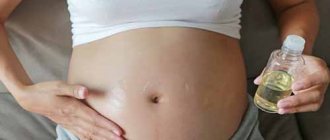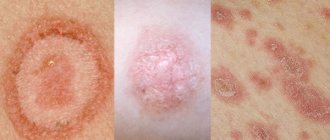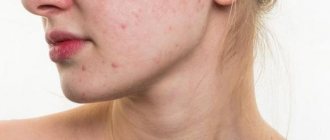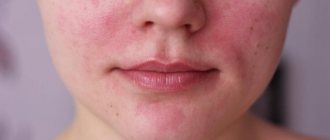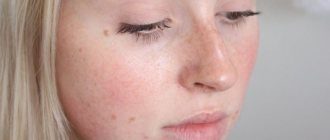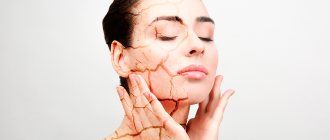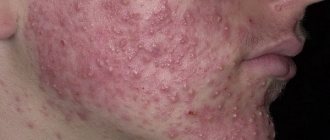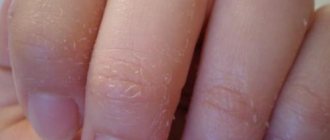The most long-awaited and enjoyable time in a woman’s life is pregnancy. And often during this period all sorts of unpleasant surprises appear. Pregnancy is accompanied by emotional outbursts, changes in a woman’s entire body, old diseases may worsen or new ones may appear. Among the unpleasant surprises are red spots on the face that peel off.
In humans, skin color is affected by the concentration of melanin. It is found in melanosomes, which help protect the top layer of skin from ultraviolet rays. When pregnancy occurs, the body is completely rebuilt, hormonal changes occur, and the amount of melanin also changes. It is produced in volumes greater than normal, and therefore is located on different parts of the body and face. That's why red spots appear on the face.
Red spots on the face may appear if a woman took oral contraceptives before pregnancy. Epilepsy medications can have the same effect. Red spots on the face may indicate a lack of folic acid in the body.
There are other causes of pigmentation. Among them are hereditary factors, pathologies in the liver, ovaries, and low-quality cosmetics.
Under the influence of ultraviolet radiation, pigmentation only intensifies, so it is advisable for women to spend less time in the sun during pregnancy. This problem begins to disappear around two months after the baby is born. But there may also be cases when the spots do not disappear for several years. Which happens rarely.
If this problem causes discomfort and discomfort, you can seek help from a cosmetologist or dermatologist. In cases where this is a consequence of an allergy to cold or sun, the following symptoms appear:
- red spots on the face are peeling;
- the skin becomes rougher and rougher;
- redness intensifies under the influence of provoking factors;
- spots may itch and tighten the skin;
- characteristic places of occurrence are the chin, cheeks, and nose.
Types of examination for spots on the face:
- visiting a number of doctors: dermatologist, endocrinologist, neurologist, gastroenterologist;
- blood tests;
- immunogram;
- allergen tests;
- scraping the stain;
- if there is a suspicion of diseases of the internal organs: ultrasound, colonoscopy, gastroscopy and others.
Speaking from a medical point of view, getting rid of pigmentation during pregnancy is not advisable. Because this is an absolutely normal phenomenon. And there is no harm to either the mother’s body or the fetus. The best option is to wait until the spots go away on their own.
But not everyone can wait; many feel discomfort, which causes complexes to appear. There are several ways to remove stains. And they will not harm the baby in the womb.
A variety of lotions and masks offered by traditional medicine have a good effect. You can use different products and wipe the stains. They help a lot:
- parsley juice, which has a whitening effect;
- cranberry juice;
- red currant;
- raspberries;
- strawberries;
- Luke;
- sweet pepper.
The swab should be soaked in juice, wipe the stains and not rinse off. You can do this a couple of times during the day.
Sour cream and milk are mixed in equal parts, a gauze swab is soaked in this mixture and applied to the face. Leave on for 20 minutes and rinse off.
Lemon juice is mixed with honey (2 tablespoons), a gauze swab should be soaked in this solution and left on the face for half an hour.
Gauze can be soaked in yogurt. You can cook it yourself or buy it at the store.
Red spots can be wiped with kefir, left for fifteen minutes, and then applied parsley juice.
Cucumber gruel will help. Keep on your face for about 20 minutes and rinse with lukewarm water. The same mask can be made using parsley.
It is enough to apply lotions before going to bed. It is advisable to use these folk remedies if you are not allergic to any component of the mask; you must be careful.
Cosmetics can also help hide this problem on the face during pregnancy. The main thing is that they are natural, since everything that the mother’s skin absorbs will get to the baby.
If you follow certain rules during pregnancy, you can prevent the appearance of spots. It is undesirable to be in the sun from twelve to six o'clock in the evening. And before going outside, you should apply a high-protection sun cream.
Use only natural cosmetics. If your doctor recommends taking vitamins, do not ignore this advice. Eat healthy and balanced. It is very important not to forget that, most likely, the red spots will go away on their own after childbirth, so there is no need to worry.
Sometimes a woman develops red spots on her face that are similar to pigment spots. Most often it is an allergy to something. Therefore, you should consult a doctor and, if necessary, be examined. If the stimulus is excluded, they will disappear. Allergies during pregnancy should not frighten or surprise, as different processes occur in the body.
Pregnancy is accompanied by changes throughout a woman’s body; old diseases may worsen or new ones may appear. Among the unpleasant surprises are red spots on the face that peel off.
The most long-awaited and enjoyable time in a woman’s life is pregnancy. And often during this period all sorts of unpleasant surprises appear. Pregnancy is accompanied by emotional outbursts, changes in a woman’s entire body, old diseases may worsen or new ones may appear. Among the unpleasant surprises are red spots on the face that peel off.
This cosmetic defect has many causes. Red spots can form for the following reasons:
In humans, skin color is affected by the concentration of melanin. It is found in melanosomes, which help protect the top layer of skin from ultraviolet rays. When pregnancy occurs, the body is completely rebuilt, hormonal changes occur, and the amount of melanin also changes. It is produced in volumes greater than normal, and therefore is located on different parts of the body and face. That's why red spots appear on the face.
Red spots on the face may appear if a woman took oral contraceptives before pregnancy. Epilepsy medications can have the same effect. Red spots on the face may indicate a lack of folic acid in the body.
There are other causes of pigmentation. Among them are hereditary factors, pathologies in the liver, ovaries, and low-quality cosmetics.
Under the influence of ultraviolet radiation, pigmentation only intensifies, so it is advisable for women to spend less time in the sun during pregnancy. This problem begins to disappear around two months after the baby is born. But there may also be cases when the spots do not disappear for several years. Which happens rarely.
If this problem causes discomfort and discomfort, you can seek help from a cosmetologist or dermatologist. In cases where this is a consequence of allergies to cold or sun, the following symptoms appear:
- red spots on the face are peeling;
- the skin becomes rougher and rougher;
- redness intensifies under the influence of provoking factors;
- spots may itch and tighten the skin;
- characteristic places of occurrence are the chin, cheeks, and nose.
Treatment with folk remedies
Speaking from a medical point of view, getting rid of pigmentation during pregnancy is not advisable. Because this is an absolutely normal phenomenon. And there is no harm to either the mother’s body or the fetus. The best option is to wait until the spots go away on their own.
But not everyone can wait; many feel discomfort, which causes complexes to appear. There are several ways to remove stains. And they will not harm the baby in the womb.
A variety of lotions and masks offered by traditional medicine have a good effect. You can use different products and wipe the stains. They help a lot:
- parsley juice, which has a whitening effect;
- cranberry juice;
- red currant;
- raspberries;
- strawberries;
- Luke;
- sweet pepper.
The swab should be soaked in juice, wipe the stains and not rinse off. You can do this a couple of times during the day.
Sour cream and milk are mixed in equal parts, a gauze swab is soaked in this mixture and applied to the face. Leave on for 20 minutes and rinse off.
Lemon and honey
Lemon juice is mixed with honey (2 tablespoons), a gauze swab should be soaked in this solution and left on the face for half an hour.
Curdled milk
Gauze can be soaked in yogurt. You can cook it yourself or buy it at the store.
Kefir
Red spots can be wiped with kefir, left for fifteen minutes, and then applied parsley juice.
Cucumber
Cucumber gruel will help. Keep on your face for about 20 minutes and rinse with lukewarm water. The same mask can be made using parsley.
It is enough to apply lotions before going to bed. It is advisable to use these folk remedies if you are not allergic to any component of the mask; you must be careful.
Cosmetics can also help hide this problem on the face during pregnancy. The main thing is that they are natural, since everything that the mother’s skin absorbs will get to the baby.
Prevention measures
If you follow certain rules during pregnancy, you can prevent the appearance of spots. It is undesirable to be in the sun from twelve to six o'clock in the evening. And before going outside, you should apply a high-protection sun cream.
Use only natural cosmetics. If your doctor recommends taking vitamins, do not ignore this advice. Eat healthy and balanced. It is very important not to forget that, most likely, the red spots will go away on their own after childbirth, so there is no need to worry.
Sometimes a woman develops red spots on her face that are similar to pigment spots. Most often it is an allergy to something. Therefore, you should consult a doctor and, if necessary, be examined. If the stimulus is excluded, they will disappear. Allergies during pregnancy should not frighten or surprise, as different processes occur in the body.
Pregnancy is, of course, a very pleasant period in the life of every woman, but at the same time, this period is full of surprises, and not always pleasant ones.
Physiological and emotional new sensations, the first signs of pregnancy, various changes in the entire body, in all organs and systems, exacerbations of long-standing hidden diseases, and sometimes the emergence of new ones - all these are possible companions to the period of bearing a baby. One of the surprises of pregnancy is the appearance of age spots in the expectant mother. These spots can appear not only on the face, but throughout the body, in the most unexpected places.
Symptoms
Oral dermatitis in pregnant women manifests itself in the area around the mouth, affecting the chin and cheeks. It all starts with the appearance of a slight red rash in the indicated areas. Over time, the manifestations become more stable. In this case, other signs of oral dermatitis occur:
- small red pimples
- skin itching at the site of inflammation,
- burning sensation,
- feeling of tight skin.
After a few days, the symptoms change slightly:
- the number of acne increases,
- the rash takes on a symmetrical shape,
- pimples become watery
- over time, pustules appear at the site of the rash,
- the skin at the site of inflammation becomes covered with dry scales.
The first signs of an inflammatory process on the skin are not difficult to recognize. However, only a qualified specialist can establish an accurate diagnosis after carrying out special procedures.
In order to stop inflammation in time and eliminate unpleasant manifestations, the expectant mother needs to consult a doctor immediately after the appearance of a rash on her face.
Diagnosis of oral dermatitis during pregnancy
Diagnostics are necessary for two reasons:
- to determine the type of dermatitis and prescribe an effective course of treatment;
- to exclude the presence of other skin diseases.
Similar manifestations are also characteristic of other skin diseases:
- contact dermatitis,
- neurodermatitis,
- allergic dermatitis,
- acne,
- seborrheic dermatitis.
Peroral dermatitis can be diagnosed after a number of procedures:
- inspection of external manifestations,
- descriptions of the condition of the expectant mother based on her complaints,
- bacteriological culture of scrapings from the site of inflammation.
Causes of age spots during pregnancy
There may be several reasons for the appearance of age spots during pregnancy:
- Firstly, the color of any person’s skin always depends on several factors, but the main one is the concentration of the pigment (dye) - melanin.
Its concentration takes place in molecules called “melanosomes”. These melanosomes act as a natural filter that protects the outermost layer of human skin from the harmful external effects of ultraviolet radiation; - Secondly, since with the onset of pregnancy, hormonal changes occur in a woman’s body, the process of melanin production also undergoes changes.
The adrenal glands begin to increase the production of estrogen, progesterone and melanocyte-stimulating hormone. Therefore, melanin is produced in extremely large quantities during this period, and begins to concentrate on certain areas of the skin of the face and body of a pregnant woman. And this, in turn, leads to hyperpigmentation; - Thirdly, hyperpigmentation is the appearance of brownish spots of various shapes on the back, on the neck, around the nipples on the mammary glands, in the décolleté area, on the face (the forehead, cheeks, chin and upper lip are usually affected by pigmentation).
As a rule, hyperpigmentation begins in the second trimester, less often, it can occur a little earlier; - Fourthly, hyperpigmentation can occur if a woman used oral contraceptives or drugs to treat epilepsy before pregnancy. Or hyperpigmentation may indicate a deficiency of folic acid in the female body;
- Fifthly, hyperpigmentation can occur due to pathology of the liver, pituitary gland, ovaries, or due to incorrect use of perfumes and cosmetics. Poor-quality cosmetics can also cause skin pigmentation during pregnancy;
- Sixthly, pigmentation can occur due to hereditary predisposition.
Increased pigmentation occurs with ultraviolet radiation, from which we can conclude that pregnant women need to hide from the sun; - And lastly, as a rule, chloasma (the appearance of pigmentation) disappears within the first two months after childbirth.
True, it happens that stains remain for several years. But this is a rare occurrence. If pigmentation gives a woman discomfort, it is worth consulting a doctor - a dermatologist or cosmetologist.
Causes
Any illness on the face can ruin your mood. The already emotional expectant mother becomes sad and worried. She is worried about where the red spots on her face came from and whether they will affect the child’s health.
The following reasons may contribute to the formation of red spots on the face of a pregnant woman:
- genetic predisposition;
- allergy;
- lack of folic acid;
- age-related changes;
- avitaminosis;
- pathologies of the liver and ovaries;
- skin infections of fungal, bacterial, viral nature;
- mite damage to the skin;
- diseases of internal organs;
- disruption of the hormonal system and metabolic disorders;
- stressful conditions;
- skin diseases.
Pigmentation increases due to ultraviolet radiation. For this reason, during pregnancy, the time spent in the sun should be reduced. Approximately 2 months after birth, the spots will disappear. In rare cases, they can remain on the skin for several years.
As a rule, during pregnancy, the cause of spots is an allergy, the symptoms of which are most often localized on the cheeks. Spots and dots on the face itch and dry out. They can be the size of a small grain or up to large coin sizes, from pale pink to deep red.
Allergic dermatitis can be caused by exposure to the sun or low temperatures, cosmetics or medications, or food. It is important to identify the allergen and eliminate it immediately.
How to get rid of pigmentation?
In general medical terms, getting rid of pigment spots during pregnancy is absolutely not advisable, since they have no harmful effect on either the health of the mother or the development of the fetus. It is best to wait until the pigmentation disappears on its own during the postpartum period.
But, if pigment spots still cause discomfort to the expectant mother, there are some ways to remove them that are quite acceptable for use during the period of bearing a child. Below we present several folk recipes that will help reduce the intensity of skin pigmentation in the expectant mother during pregnancy.
Traditional recipes for skin pigmentation
Means for wiping: you can wipe your face with freshly squeezed juice of parsley, cranberries, onions, fresh cucumbers, red currants, strawberries, sweet peppers, raspberries. After soaking the tampon in the juice, simply wipe your face several times a day. There is no need to wash off the juice from your face.
Gadgets:
- mix lemon juice with two tablespoons of honey, soak a gauze pad in the solution, hold on your face for twenty minutes, then rinse with warm water;
- soak gauze in fresh yogurt, apply to your face, after twenty minutes rinse with warm water;
- mix milk and sour cream one to one, moisten a gauze swab with the solution, apply to the face, after twenty minutes rinse with running warm water.
It is enough to do such lotions once a day before going to bed.
Masks:
- you need to grind any whitening berries (the berries are listed above), make a face mask from the resulting pulp for fifteen minutes;
- directly lubricate the pigment spot with fresh kefir for fifteen minutes, after kefir, wipe the stain with freshly squeezed parsley juice;
- Grind fresh cucumber in a blender and apply on face for twenty minutes. Then rinse with cool water;
- Grind the parsley in a blender, apply the pulp on your face for thirty minutes, then rinse with cool water.
Any of these folk remedies should be used if the woman is not allergic to any component of the recipe. And in order not to cause an allergic reaction, you must use any of the recipes with great caution.
To disguise age spots during pregnancy, it is necessary to use cosmetics that are made on natural plant bases. It is necessary to take into account the fact that everything that is absorbed by the mother’s skin also gets to the baby. Therefore, you should not risk the health of a new developing organism.
Therapy
The best treatment for allergies during pregnancy is to completely eliminate contact with the allergen. To do this, you need to take the following measures:
- It is recommended to use mattresses and pillows made of synthetic materials.
- Remove all carpets from the house.
- Temporarily prevent contact with pets.
- Control your diet.
- During mass flowering of plants, you need to limit the time you spend walking outside, especially avoid the period from 5 to 10 am.
- Take a shower and change clothes after sleep.
Delicious recipe! Meatballs with minced fish and rice
Traditional medicine
Drug therapy should be carried out strictly under the supervision of a doctor, since many drugs can have a detrimental effect on the fetus. It is not recommended to treat allergies yourself.
2nd generation antihistamines: Cetirizine and Loratadine are considered relatively safe. 1st generation antihistamines and intranasal agents are contraindicated.
To relieve itching and relieve skin symptoms, you can use preparations for external use. For the sake of safety for the fetus, medications containing hormones are not recommended, especially in the first trimester of pregnancy. Of the approved ointments you can use: Bepanten, D-panthenol, Zinc ointment .
Folk remedies
Rashes on the face may go away on their own after eliminating allergens. To relieve symptoms, the following methods are used:
- To reduce itching, you can wash your face with warm water and baking soda. Do not use very hot or cold water or use soap. It is forbidden to scratch the skin of the face, as it can cause infection and aggravate the process.
- For severe itching and burning in the area of the rash, crushed nettle is used. To prepare a decoction, pour 1-2 tablespoons of dried herbs with a glass of boiling water and let it brew. After this, wipe the face with the resulting infusion 3-4 times a day.
- Nettle can be consumed internally in the form of tea. The tea is prepared by adding 1 teaspoon of dried nettle leaves to a glass of boiling water and steeping for 5 minutes. For a pleasant taste, you can add honey, sugar, cream. Tea is contraindicated in the first trimester of pregnancy because it has a uterotonic effect, that is, it increases the tone of the uterus. But starting from the second trimester, you can safely drink this healthy drink.
- Another popular tonic and antiallergic folk remedy is honey. It is believed that honey obtained from bees in the area where a person lives may have an anti-allergic effect when reacting to the pollen of plants growing in that region. Honey should be consumed internally in its pure form or added to tea.
- St. John's wort can be used to lubricate the affected areas of the face. Oil is prepared from this plant. Dry crushed leaves of St. John's wort are poured with olive oil and left for a week. Apply to affected areas of facial skin after washing.
Any home method or remedy must be agreed upon with a gynecologist.
Prevention of skin pigmentation during pregnancy
In order not to provoke the appearance of pigmented brown spots on your skin during pregnancy, first of all, you must follow some rules:
- Absolutely avoid exposure to the sun at dangerous times - from noon to eighteen o'clock in the evening. At this time you need to be in a shady place;
- Before going outside, be sure to use sunscreen with a high level of protective factor;
- Strictly avoid contact with skin of various chemicals;
- Use exclusively proven and natural cosmetics;
- Take multivitamins as recommended by your doctor;
- Follow a balanced diet, which will contain a lot of vegetables, beets, cabbage, liver, fish products, vegetable oils, and cereals.
And the main thing to remember is that any age spots, in ninety-eight percent of cases, disappear shortly after childbirth, so there is absolutely no need to worry too much about their appearance.
Red spots during pregnancy
Sometimes women develop spots similar to pigmentation, but red in color, on the face and body. In most cases, this is one of the manifestations of an allergic reaction to something. With this type of stain, you should consult a doctor and undergo additional examination. After it, it will be clear what the body reacts to with this manifestation.
By eliminating the irritant from the life of a pregnant woman, red spots, as a rule, disappear by themselves. There is absolutely no point in being surprised by an allergic reaction during pregnancy, since the body can present various surprises throughout the entire period.
Many mothers, having gone through all the trials of pregnancy, are familiar with this phenomenon when their appearance changes almost beyond recognition. The face may change during pregnancy, brown or white spots appear, depending on the natural pigment of the skin, deep pimples, small rashes and swelling.
Our grandmothers were also able to determine whether a woman was pregnant or not based on one sign. No, no, we don't mean a clearly visible rounded tummy. Pregnancy can be determined in the early stages, when only future parents can know about it, by looking at the face. For some women it does not change, but for some, as they say, “pregnancy is obvious.” By what signs can this be determined and what happens to a woman’s appearance?
Diseases of internal organs
Many pathologies can be accompanied by itching or rash on the skin. For example, diabetes mellitus, when due to an increase in sugar levels in the skin certain changes occur, leading to itching. A woman may also feel thirsty and her appetite increases excessively.
Establishing a diagnosis is often not very difficult, and it is not difficult to do, since every pregnant woman is regularly examined. Diabetes treatment is carried out only by an endocrinologist. No independent treatment or use of traditional medicine methods should be undertaken without consulting a specialist.
Itchy skin can also occur with hepatitis. This liver disease occurs for various reasons: under the influence of viruses, medications, due to disorders in the immune system, toxic lesions, etc. Hepatitis is a fairly serious pathology that requires careful monitoring and adequate treatment.
Very often, pregnant women experience swelling of the arms and legs for one reason or another. This occurs due to varicose veins, diseases of the cardiovascular system, and changes in mineral metabolism. Most often, stretched skin on the legs below the knees and fingers itch.
Various chronic skin diseases tend to worsen during pregnancy, and for some of them, pregnancy is a provoking factor. This group of diseases is accompanied by the appearance of rashes. They can have different colors, but most often they are red in color, disappear or not when pressed, and be located on any part of the body.
Often during pregnancy, a woman notices white spots appearing on the skin. Why do they arise? There may be several answers at once. The first thing the doctor should rule out is skin diseases. A not very pleasant diagnosis that can be given to a woman is lichen (of various types).
These are pityriasis versicolor and ringworm, syphilitic manifestations in the form of the so-called necklace of Venus. It is worth noting that such diagnoses are rare. More often, white spots appear with non-contagious pityriasis rosea. Currently, they are inclined to believe that its appearance is associated with a viral infection that becomes more active against the background of weakened immunity.
Quite often, white spots during pregnancy can be mistakenly mistaken for a skin pathology by the woman herself. However, contacting a specialist solves the problem. They may be traces of abrasions or scratches received some time ago. Sometimes these spots may have a reddish tint if the microtrauma was recently received.
Most often, white spots of post-traumatic origin are located on open areas of the skin of the arms, legs, and face. They are completely different from a rash and do not itch.
And the last pathology accompanied by the appearance of milky white spots is vitiligo. These rashes are more noticeable in dark-skinned people or in the summer, when all the skin, except for vitiligo spots, tans.
How to tell if you're pregnant by looking at your face
First of all, the face in the 1st trimester of pregnancy may become haggard; it seems that the woman is tired or has not gotten enough sleep. Due to hormonal changes in the body, the complexion and brightness of the eyes may change. Our grandmothers could also accurately determine whether a woman was pregnant or not by the shape of her face - it was slightly elongated and rounded. Perhaps this sign indicated pregnancy, but after several weeks the woman still could not gain enough weight for it to be noticeable even on her face. Probably, the face changed due to improper functioning of the kidneys, which is quite possible during pregnancy.
You can also determine early pregnancy by a woman’s appearance if she is suffering from toxicosis. Then the face certainly takes on an “earthy” tint and characteristic pallor.
And vice versa, when a new life is born, a woman blossoms. People around you can also notice this - your face becomes smooth and a slight blush appears. It also happens the other way around, when during pregnancy rashes appear in the body due to hormonal changes. What do you need to know to cope with this problem?
External changes
The first signs of nascent life appear in appearance. Often a pregnant woman notices the following signs:
- Breast changes
. The areolas may enlarge and darken, and the venous pattern that appears through the skin of the breast intensifies. - Acne (acne)
. A sudden hormonal change leads to the fact that pregnant women, even those who have not previously suffered from acne, discover these manifestations on the skin. - Swelling of the arms, legs, face.
Swelling of the hands becomes noticeable if they are clenched into fists. It is difficult to put previously loose shoes on your feet (especially in the evening). Your face looks like you just woke up. - Redness of the facial skin
. Due to increased blood circulation, a blooming blush appears on the cheeks. It is especially clearly visible in the evening.
If you do not observe any of these signs, this does not mean that conception has not occurred. Your body may react differently to pregnancy.
Pregnancy and rashes
Let's go back to our ancestors. It’s interesting, but our great-grandmothers could tell for sure whether a woman would give birth to a boy or a girl. And they determined the sex of the baby like this: if a woman began to look worse, she had skin problems, then a girl would be born, and if the woman became prettier, then a boy would be born.
What you need to prepare for:
- If before pregnancy your skin was far from ideal, you struggled with increased sebum secretion and rashes, then after conception the situation will not improve. There is a high chance that your skin will look worse and all your problems will get worse.
- If you have never encountered such a problem as acne and pimples, then during pregnancy you cannot be immune from their occurrence. Everything will depend on the hormonal background.
There is nothing good about having skin rashes. Let's figure out why this happens and how to restore beauty and freshness to your skin.
Why do acne appear?
As mentioned earlier, rashes appear due to hormonal changes. In the body of a pregnant woman, the amount of progesterone, the main hormone that is responsible for maintaining pregnancy and is involved in the production of sebum, increases. It turns out that the active production of this hormone inhibits metabolic processes. As a result, rashes appear.
The second reason is lack of fluid. The body becomes dehydrated, and hormones begin to work more actively. A pregnant woman should drink enough fluids so that the body does not replenish reserves on its own.
Skin changes in the form of rashes often appear at the beginning of pregnancy, when the woman has not yet had time to adapt to hormonal fluctuations. Many mothers worry whether they will be able to get rid of acne after childbirth. Even a gynecologist cannot answer this question unequivocally, since in some pregnant women the rashes go away on their own in the 1st trimester, some continue to struggle with acne for 9 months, and there are also cases when unpleasant rashes “accompany” the woman for a long time and after childbirth. This is the fault of the female sex hormone - estrogen. So you won’t be able to get rid of this unpleasant cosmetic defect during pregnancy once and for all. Moreover, you need to take into account that using hormonal drugs to treat acne while carrying a baby is prohibited. All that remains is to properly care for your skin to keep it in good condition.
How to deal with rashes
An effective method is to cleanse your face. Pregnant women are allowed to undergo this procedure.
What do we mean by the word “cleaning”? In short, the procedure involves opening pores and clearing clogged sebaceous glands. After cleaning it is necessary to do anti-inflammatory therapy. Pregnancy is not a reason to refuse to cleanse the sebaceous glands on the face; let’s learn more about popular methods of cleansing the skin.
These include:
- Ultrasonic cleaning. Performed using high frequency sound vibrations. Not only the pores are cleansed, horny particles are also removed, and blood circulation is stimulated. It is allowed for pregnant women if there are no ulcers on the skin, its integrity is damaged or rosacea is pronounced.
- Facial cleansing using the vacuum method is a gentle procedure. Allowed for pregnant women. How it happens: under vacuum, pressure from the tip acts on the sebaceous glands, as a result they are freed from dirt and sebum. After the procedure, the face looks fresh and rested. Vacuum facial cleansing is recommended for those with skin with enlarged pores. This procedure should not be done if there is inflammation or rosacea.
You can get rid of acne on the face during pregnancy if you cleanse your face once every 3 months.
The procedure consists of several stages:
- Cleansing. The skin is freed from decorative cosmetics with the help of soft anti-allergenic cleansing compositions: gels, foams or milk. The choice of product will depend on your skin type.
- Exfoliation. It is used if the skin is not steamed. Then creams with enzymes and fruit acids are used. Pregnant women can do steaming or choose the 2nd option.
- Opening of pores. It is performed using a special device - a valorizer. You should not steam the skin if blood vessels are close to each other, there is heavy hair growth, the patient has high blood pressure or has bronchial asthma. Instead of hardware steaming, you can apply a special product to the skin that opens the pores on the face.
- Cleansing. This stage of facial cleansing can be performed in 2 ways: mechanical and hardware. In the first case, dirt is removed manually using special tools (spoons, loops). It is long and painful, but effective. In case 2, ultrasound or vacuum is used. Pregnant women can choose an acceptable way to cleanse their skin.
- Closing of pores and restoration stage. A clay mask with the addition of mineral components (zinc, potassium) is applied to the skin; a damp cloth is placed on top of the mask to more actively affect irritated skin. As a result, the skin will become smooth, radiant, minor rashes and even age spots will disappear. The Darsonval procedure is contraindicated.
- The final stage. Cream is applied to the skin (nutrition, hydration, soothing effect).
The facial cleansing procedure is lengthy but effective. After treatment, rashes will disappear on the skin, it will become fresh and rested. For those women who, for various reasons, cannot visit a cosmetologist, there is an alternative option - independent skin care at home.
You need to start by choosing a cosmetic cleanser that will suit your skin type. You need to cleanse your skin 2 times a day, use tonic and creams that do not clog pores. 1, maximum 2 times a week you can do peeling and mask. A qualified specialist will help you choose the right cosmetics. And yet, it is important not only to regularly care for your skin, you need to eat right and spend more time in the fresh air. If you continue to smoke and are already carrying a baby under your heart, think about his health - it’s never too late to start leading a healthy lifestyle.
What else do you need to know
- Eat more fresh fruits and vegetables. Don’t forget about crumbly cereals and protein, but it’s better not to eat fatty and smoked foods for now.
- Drink plenty of clean water. Tea and juices are not included in the total amount of fluid consumed (2-2.5 liters per day).
- You cannot squeeze out acne on your own, as this can spread the infection and harm yourself. During the period of bearing a baby, a woman’s immunity is weakened, so that after squeezing out acne, the localization sites can take a long time to heal.
- Do not forget about proper digestion; stagnation in the intestines leads to inflammation of the skin.
- Cleanse your skin 2 times a day with special products.
- As a preventative measure, you can use natural masks made from fresh strawberries, raspberries, grapes or apricots.
Skin itching “out of the blue”
Skin irritation without visible lesions has more than twenty causes, including cancer
The most common reason for visiting a dermatologist is itching. There are cases when there are not even any rashes on the skin, but it itches so much that a person literally tears the skin. The suffering is further aggravated by the fact that everyone around them suspects a simulation or a mental disorder.
And, it would seem, it’s not a big problem - a person scratches himself, and that’s it, there are no specific skin diseases, let him be happy. But itching can indicate very serious problems, not to mention the fact that it greatly worsens the patient’s quality of life. Constant itching can lead to depression and even suicide attempts.
The most serious reason
The most important causes of itchy skin are malignant tumors. Itching may be one of the first signs of a tumor and appear before other symptoms. There have been cases when such a difference was up to 5 years!
Paraneoplastic (tumor-associated) skin itching can occur with any tumor, but more often occurs with carcinoma of the stomach, pancreatic cancer, lung, intestinal, brain, breast and prostate cancer. The whole body itches, but there are areas where the itching is more intense.
With Hodgkin's lymphoma, itching is also one of the most common accompanying symptoms and is observed in 25% of patients suffering from this disease.
If “thanks to the itch” you are examined on time, then cancer can be caught in the early, treatable stages.
Water: helps and provokes
Not as fatal as hidden tumors of internal organs, and perhaps the most common cause of itching is simple dry skin.
Spots on the face during pregnancy
Redness and spider veins
From approximately the 10th week of pregnancy, the volume of circulating blood in a woman’s body increases. By the end of pregnancy, its volume will increase by 40%. If the baby is large, then this figure may be higher. Accordingly, the load on a woman’s vessels increases; they may not be able to cope with the pressure of the liquid, bursting or becoming clogged.
A woman can find out about this immediately by characteristic signs. If the palms of your hands and soles of your feet often turn red, and red “stars” appear on the skin, it means that the blood vessels are not doing their job. Vessels can burst in a variety of places, but most often this happens on the face. According to gynecologists, 60% of women wear such “jewelry” during pregnancy. And if redness of the extremities is a passing phenomenon, then it is very difficult to get rid of burst capillaries on the face. They can remain on the face throughout life. If a woman is not satisfied with this phenomenon, then she can get rid of the cosmetic defect after childbirth using a laser. 1-2 procedures - and you can forget about the red mesh forever. In the meantime, you will have to mask red spots on the face during pregnancy with cosmetics.
Pigment spots on the face during pregnancy
With each week of pregnancy, small surprises await a woman. They are not always happy. For example, if you go to the mirror, you will notice that certain areas of the skin have become darker. The hollows under the armpits and nipple halos have noticeably darkened - this is the work of the hormone progesterone. It forces skin melanocytes to work in double mode, that is, to produce more pigment. The cells obediently cope with the task, but the skin of a pregnant woman may suffer from this. Most often, pigmentation appears in those areas that were previously, even before conception, darker (this cannot be seen with the naked eye) - on the cheeks, forehead, chin, above the upper lip and the back of the nose. The medical term for this phenomenon is called “chloasma” or “mask of pregnancy.” Chloasma appears as early as 12 weeks of pregnancy. Or it may happen that for 9 months there are no pigment spots, but a few months after birth they appear.
Dark spots on the face during pregnancy are a natural phenomenon and go away on their own after the birth of the baby. True, this will not happen immediately, but after 2-3 months (maximum - after a year).
If a woman wants to speed up the disappearance of spots, then she can take care of her skin already during pregnancy.
How to get rid
- Make a face mask from kefir or natural homemade yogurt. Apply kefir to the darkened areas and leave for 15 minutes. You can wash it off with warm water.
- Make a mask from the pulp of fresh cucumbers and apply the paste to problem areas.
- You can chop parsley in a blender (leaves along with roots). The juice can be strained and poured into a separate clean container (you can wipe your face with it), and place the pulp in gauze and place it on the affected areas.
- Lemon or grapefruit juice works well to lighten stains. Apply it to the skin and rinse with water after 20 minutes.
Prevention of pigmentation
Remember that the appearance of age spots on the face can be prevented even during pregnancy. To do this, it is necessary to apply sunscreen (SPF 30 or more) before going outside, not only in the warm season, but also in cold weather, since ultraviolet rays can even penetrate clouds and be reflected from snow.
How to avoid stains:
- Your daily diet should consist of fruits, vegetables, cereals, fish or meat. Don't forget about vegetable oil.
- Protect your skin from sunlight. In addition to the cream, buy a special lipstick.
- Do not try new cosmetology products; during pregnancy, the skin can react in different ways: pigmentation, rashes and even swelling.
- Drink plenty of fluids (up to 2.5 liters per day).
- You can't drink coffee or black tea.
- Avoid stress.
- Visit an endocrinologist - he will check the functioning of the thyroid gland.
You should not do laser resurfacing and chemical peeling during pregnancy, or use products with vitamin A. And remember that prolonged exposure to the sun will not solve your problems and tanning will not be able to mask pigmentation, it will only intensify.
Fighting pigmentation after childbirth
After the baby is born, you can get to work and lubricate the darkened areas on your face with special creams or serums containing fruit acids. If the spots do not go away even after a year or they have increased, then you need to consult a gynecologist, endocrinologist and dermatologist. If everything is in order, then you can get rid of dark areas on your face in a beauty salon. Along with whitening cosmetics, you can use folk remedies.
Symptoms
Facial allergies during pregnancy can manifest themselves in the form of pinpoint rashes, hives, dry skin, swelling of facial tissues, and itching at the site of the rash.
Urticaria is the formation of itchy blisters against a background of swollen skin. A severe course may be complicated by the development of Quincke's edema . In this condition, the paraorbital areas and lips swell, and swelling of the larynx may occur, which will lead to difficulty breathing.
Skin allergies during pregnancy are often accompanied by the development of allergic conjunctivitis and rhinitis. This is manifested by redness of the sclera, increased tearing, and copious serous discharge from the nose.
